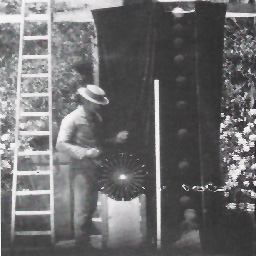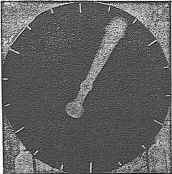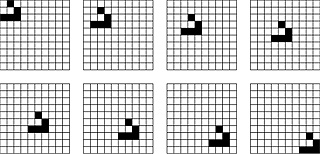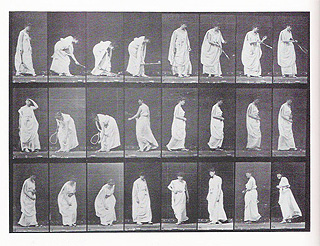Chronophotography was developed, at the end of the nineteenth century by Marey, Demenÿ and later Gilbreth and used as a tool for investigating movement. At the beginning of the twentieth century chronophotography’s potential as a research tool was ignored as aspects of chronophotography were developed into cinema. Now, in what many call the post-cinematic era1, artists and researchers are beginning to return to chronophotography to continue some of its unfinished stories. A chronophotograph contains information about interval, duration, speed and other derivatives of space and time. This information can and has been used to answer questions about motion and mechanical efficiency. In this paper I want to demonstrate how chronophotography can be used to better understand two of its descendents: animation and cinema.
We are familiar with the evidence. In the cinema, we know that a sequence of still images is projected one after another onto a viewing screen. We also know that the differences between any two consecutive images must be small and that the sequence of images must be shown quite quickly. We might even know that this system works whether the images are recorded photographically, as in cinema, or hand-made by drawing or some other method, as in animation. What we do not know is how the system works. We can guess or use trial and error to determine how small the differences between consecutive images should be and how quickly the sequence of images must be shown. But, why does a sequence of still images appear to be a continuous moving image?
The answer that is most often given (usually in the first chapter of film books, cinema books and animation books) is “Persistence of Vision”. The idea is that the visual system retains each static image for a short time and so a rapid succession of slightly different still images will appear to be fused together into one continuous moving image. Persistence of vision exists. Persistence of vision is an accurate description of the effect we notice when a small bright light is rapidly moved about in a dark room or other relatively dark space. If the conditions are right, we will see this rapidly moving dot of light as a static line. Persistence of vision exists, but it is not the answer to our question. Indeed, persistence of vision and cinema are in opposition. We want to avoid persistence of vision if we want a sequence of still images to be seen as a continuous moving image, for if persistence of vision was involved in a sequence of rapidly changing images the images would intrude into one another and the highlights of the images would fuse into a number of static blurs. Because this, the wrong answer, has been repeated often and for many years it has reached the status of a myth and it persists because it is invoked without hesitation to answer the question: “how do animation and cinema produce the illusion of continuous motion?”.
I would argue that the correct answer to this question could inform the practice of filmmakers and animators and might even help to create new forms of practice.
This paper will demonstrate that the correct answer to our question is to be found in two parts, in two neglected corners of chronophotography. The first part of our answer is prompted by an analysis of Marey’s chronometric dial. This device appears in many of his chronophotographs and is clearly shown in Figure 1, a photograph of a chronophotographic recording session.
The chronometric dial is essentially a one-handed clock without any numbers. The hand is highly reflective, and so appears white in a monochrome photograph, and it is turned at a constant rate against a circular black velvet background. The clock’s hand makes one complete revolution in 90 seconds and the circumference of the circular dial is divided into 18 equal sectors. This device was used by Marey to measure the duration of the intervals of time between successive positions of a moving object. So, a chronophotograph (such as Figure 1) will show several images of a moving object and several images of the clock’s hand (this detail is shown in Figure 2). The images of the moving object will be various distances from each other and these distances are proportional to the space that the object has moved. The time taken to travel these distances is indicated by the angles in-between the corresponding positions of the images of the rotating clock hand. The device is useful for at least one other purpose. If the exposure is relatively long the image of the needle is blurred, as shown in Figure 3, and the extent of this blur is proportional to the duration of the exposure. In this way, the one chronophotograph has many uses. The continuous movement of the object is broken down into a number of images of the object in successive positions.
The analytical use of chronophotography has been well documented, but the use of the chronometric dial to determine the speed and acceleration of a moving object has largely been overlooked.
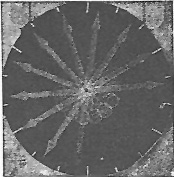
Fig. 2 – Successive positions of the needle on the chronometric dial, measuring the intervals of time separating the successive exposures3
In my practice as an artist I have attempted to complete some experimental work using chronophotography. My first steps were to recreate some of the demonstrations that I had read about. To do this, I looked for a clock that could be used as a chronometric dial. It is important that the second-hand rotates continuously and uniformly, but the second-hand on a quartz movement clock rotates in discrete steps. The frequency of the mains electricity (50 Hz or 60 Hz) is stepped down to 1 Hz and this frequency is used to time the movements of the second hand. So the quartz movement clock pulses from second to second. As well as 1 Hz quartz movement clocks there are 16 Hz quartz movement clocks. I attached a second-hand to a 16 Hz movement. When I watched the hand rotate it appeared to move continuously but in fact, the second-hand moves intermittently, in pulses, sixteen times per second. These shorter, more frequent pulses are also silent. Hence, this is called a “silent sweep” quartz movement.
There are important differences between our perceptions of a ‘normal’ 1 Hz clock and a ‘silent sweep’ 16 Hz clock. To understand the implications of these differences we need to compare what we know to be happening with what we are seeing.

Fig. 4 – Successive positions of the second-hand of a 1 Hz clock
The ‘normal’ quartz movement clock pulses once a second (1 Hz) and the second-hand is alternately stationary at one of 60 positions around the dial or quickly moving the 6° gap between these positions. The angle moved in 1 second by the second-hand of a 1 Hz clock is shown in Figure 4. The second-hand moves across the gap of 6° in 0.5 second. This is the period of the second-hand’s movement.

Fig. 5 – Successive positions of the second-hand of a 16 Hz clock
The “silent sweep” quartz movement clock moves at the same speed and intermittently stops in the same way, but at a higher frequency of 16 times per second (16 Hz) and the distances it moves in-between static positions is reduced to 3/8°. The angle moved in 1 second by the second-hand of a 16 Hz clock is shown in Figure 5. The second-hand moves across the gap of 3/8° in 1/32 second.
The difference between our perceptions (of the second-hands) of the two clocks is that we see the second-hand of the lower frequency clock as if it were jumping from position to position, but we see the second-hand of the higher frequency clock as if it was moving continuously and smoothly. This suggests a relationship between the frequency of what is seen and our perceptual ability to resolve that frequency. The power to visually resolve fine gaps and short time intervals is called spatial and temporal acuity.
Simple graphs can demonstrate the relationship between the frequency of what is seen and our acuity. The lines in the graphs represent the times when the hand of the clock is stationary. The spaces between the lines in the graphs represent the times when nothing is seen.

Fig. 6a – Graph of a low frequency (1 Hz) clock

Fig. 6b – Graph of a high frequency (16 Hz) clock

Fig. 6c – Part of Figure 6b enlarged (x 16)
Figure 6 Graphs show the relationship between the frequency of what is seen and our acuity.
Figure 6a is a graph of a low frequency (1 Hz) clock. When the frequency is higher than our acuity can resolve (This is shown in Figure 6b) we see the gaps and the intermittent signal as continuous and smooth. There is a relationship between frequency and acuity. If our acuity were more powerful, as simulated in Figure 6c, the threshold between an intermittent signal and a continuous signal would be raised. So, whether we see the intermittent signal as smooth and continuous, or not, is the result of the interaction between the frequency the signal and the acuity of the viewer.
This relationship between the frequency of the signal and the temporal acuity of our perception is the first part of our answer. This interaction is exploited by animation and cinema in two ways. The frequency of the signal corresponds to the frame rate of the projected film. If the frame rate is too low we see the individual static frames and the intervals in-between frames, but if the frame rate is higher than we can resolve then we see one continuous image. The gaps between frames are when the projection beam can be shut off and the picture can be changed. We will return to this use of the gaps in-between frames when we have understood the second part of our answer.
The second part of our answer is to be found in the work of another chronophotographer.

Fig. 7 – Arthur Mason Worthington: “Splash of a ball”
Figure 7 shows Arthur Mason Worthington’s “Splash of a ball” (Worthington 1865). It is worth understanding how Worthington made this sequence of still images. Two balls were held, suspended, by electromagnets. Both were released at the same time by turning off the electric circuit. One ball triggered a flash-light that exposed the photograph. The other ball fell into the mixture of milk and water. By varying the height of the ball that triggered the flash Worthington could record different moments in the other ball’s descent. He then put the images together in a sequence to give the illusion of a continuous series, one ball in descent. This is a simulation, by Worthington (with our willing cooperation), of a continuous set of images. Even though we know that each image of a ball falling into milk was taken independently of the other images in the presented sequence we are strongly tempted to dampen our powers of discrimination and instead see the whole sequence as representing the same ball falling into the same milk.
This demonstration suggests that if we are shown a number of images in a sequential structure (in a row, in a column, one after another on the page or on the screen) and if each pair of adjacent images appears to show a progressively incremental change then we tend to interpret each image in the sequential structure as an ordered component part of a sequence. We tend to perceive a relationship between the images even when there is none. The sequential structure cues us to make the economical assumption that each image is one of the many views of this one object in motion.
This tendency to make economic assumptions is independent of perceptual acuity and it involves both assuming that each image in a sequential structure is part of a sequence and overlooking substitutions. These assumptions are voluntary, rather than perceptual.
All these aspects are elegantly demonstrated in Figure 8. If you have chosen to see this illustration as one object gliding from the top left corner of one grid to the bottom right corner of the same grid then you have assumed motion and you have chosen to overlook the substitution of the first object by other, very similar, objects on the other grids. The two assumptions are related. If you do not assume that the eight different objects represent successive views of the same unique object you cannot assume that this one object is moving diagonally across the grid.
It can be shown that these eight objects are not views of one object in motion, and that to see them as such is voluntary, by revealing what they actually represent. These eight views are every fourth generation of a null-player game called “Conway’s Game of Life”.
Each cell in the grid interacts with the cells that are directly horizontally, vertically, or diagonally adjacent. This is illustrated in Figure 9. At each generation, the following rules are applied:
If a cell is white and three of its neighbours are black then the cell will turn black.
If a cell is black and two or three of its neighbours are black then the cell will stay black, but otherwise it will turn white.

Fig. 9 – Four generations of ‘a glider’
Now that you know what the pictures are intended to represent you can choose whether to see them as successive generations of an evolving culture or successive images of an object in motion.
Our willingness to overlook substitutions is worth closer examination. If you choose to see an object moving across the grid you have chosen to see the cluster of adjacent cells as one evolving object. Even if the moving object were to change colour and form, provided the changes were interpretable as such, we would tend to interpret what we see as one, rapidly changing, moving object rather than a relay of different objects appearing along a motion path.
A sequence will be interpreted as motion when, as in Figure 8 and Figure 9, an object appears in different locations in successive images. This is exploited in the simplest kind of animation. Using the ‘cut-out’ animation technique one can cut out a simple shape and simply move this shape between exposures of the film. When the film is projected the shape will appear to move autonomously. There are many other kinds of change that can be analysed into or synthesised from a sequence of progressively incremental changes. Examples include changes in point of view such as zooms, pans and tracking shots; physical changes such as scale and colour; changes in the environment such as lighting; and biological changes such as growth, rotting, patination and aging.
Muybridge, and later Eisenstein, demonstrated how the viewer and the filmmaker could collaborate to integrate successive views to manufacture scenes that are more than a sum of their parts.6
Here, in Figure 10, Muybridge combines a number of shots taken on different days and in a different order and then presents these disparate shots, with and without racket, in an edited order to represent movement of one subject on one occasion.
This tendency to overlook substitutions and to make economic assumptions is the second part of our answer and is exploited by animation and cinema in a number of ways. The successive images are the frames of the animation or film. The projection of these frames one after another on a screen is the sequential structure that prompts us to integrate the successive views into motion or some other kind of change. The size of the incremental change between successive frames corresponds to spacing.
Spacing is a term used in animation to refer to the change between each frame. It applies equally well to the differences between each frame of a film. The difference between spacing in animation and spacing in cinema is in the method of manufacture. Spacing is automatic in film, but must be determined by animators. Spacing in film would only become an issue (the movie would look jumpy) when the projection frame rate is much slower than the recording rate. The spacing, or the amount of change between each frame, is related to the frame rate and to the speed of the animated object. The term, “animated object”, can refer to an object animated by the animator or by the cinematic apparatus.
If we look again at the relationship between the frequency (frame rate) of the signal and our temporal acuity we will see that for any given speed (of the animated object) the spacing (amount of change between frames) is inversely related to the frame rate.
Frame rate (ƒ) x Spacing (λ) = s (speed of movement of an animated object)
For a given frame rate, an animator would increase the spacing to increase the speed of movement of an animated object. If the frame rate were increased, then for a given speed of movement the animator could decrease the spacing. Of course increases in spacing and decreases in frame rate are limited by the need to retain smooth and continuous animation. If the spacing is too large or the frame rate too low then the animation becomes jumpy.
We can now develop our earlier expression of this relationship. For any given speed of movement of an animated object when the frequency is higher and the spacing is smaller than our spatial and temporal acuity can resolve we see the gaps and the intermittent showing of the static frames as continuous and the movement as smooth. This, and not persistence of vision, explains why a sequence of still images appears to be a continuous moving image.
Each of these, ‘continuity’ and ‘motion’, can be independent of each other. We can see continuity without, necessarily, seeing motion and we can see motion without, necessarily, seeing continuity. When they come together we can see continuous motion and we have the conditions for animation and cinema.
Although continuity and motion can be independent of each other, our perceptual response and our tendency to make economic assumptions rely on each other. A faster frame rate gives the viewer, with a given temporal acuity, less time for consideration and so it is more likely that the economic assumptions will be made. If two images are presented side by side on a page (as in figures 7, 8, 9 and 10), a viewer has time to choose whether to see them as two images in a motion sequence or as something else. This choice is scarcely available when it is presented 24 times a second. Similarly, the economic assumptions make the temporal acuity more effective. That is, the threshold frame rate, at which the sequence of static images is seen as continuous motion, can be lower.
The overlooking of gaps and our willingness to overlook substitutions can be exploited because we can use the gaps (when the lights are off) to change the picture (in one frame) for a slightly different picture (in the next frame). We see the intermittent signal as a continuous image because of the interaction between the frequency of the projected images (frame rate) and our perceptual acuity. When this is combined with our tendency to integrate a sequence of incrementally different pictures into one change or movement we have a continuous and changing image, a continuously moving image.
In this paper I have sought to correct a faulty explanation of some basic aspects of the film and animation experience and to demonstrate the value of using chronophotography as a research tool for investigating space, time and movement.
A large number of diverse aesthetic codes and strategies are used within visual art to represent and construct our experiences of space, time and movement. The ideas that inform the making and viewing of these works can be clustered under a number of key ideas. These ideas include simultaneity, duration, subjective time, objective time, the instant and pace. A small number of examples will illustrate the interrelationship between the works, the ideas that inform them and the use of particular technologies.
In works such as Two Consciousness Projection(s) (Graham 1972) Dan Graham uses video to explore subjective time and the difference between time, as it is experienced, and immanent objective time. In this work, a performer is recorded whilst she is watching a monitor that shows her performance. A second performer, who is behind the camera, attempts to give an objective, distanced account of this performance. In a work such as Two Monitors and two Mirrors at opposite sides of a room (Graham 1975) Graham uses two cameras, two mirrors and time delays between the two monitors to show different modes of perception simultaneously and to bring out the discontinuity between different realities.
Nam June Paik also manipulates time to show different concepts of time and uses technology that was new at the time to exploit the phenomenon of the simultaneity of different events taking place at different times in different places. In his Good Morning Mr Orwell (Paik 1984) Nam June Paik used a satellite link to present a number of artists who were performing in Paris and New York as if they were appearing live and together on 1 January 1984.
Artists have used different strategies to force the viewer to experience time passing slowly. In Michael Snow’s film Wavelength (Snow 1967) the camera takes a single uninterrupted 45-minute shot that slowly zooms in on a loft wall. Similarly, In Andy Warhol’s film Empire (Warhol 1964) eight cameras record, in real time, nothing more than the light changing on the side of the Empire State Building. In both these films, processes that have no intrinsic interest cause the viewer to introject the passage of real time.
In contrast, artists such as Goya and Monet have represented the experience of time moving rapidly in different ways. In Goya’s Saturn devouring one of his children (Goya 1823) the indexical movement of the brush and the application of paint is used for the first time to express speed or the rapidity of movement. Saturn is the Roman name for the Greek God ‘Cronos’ who is both the God of Chaos and of Time. If we consider Monet’s works in series, such as his many paintings of Rouen Cathedral (Monet 1894), then we can see that he was attempting to paint a sequence of related instants of time. Particular codes had to be invented by Monet and other Impressionists because the act of painting a canvas clearly takes longer than the event that is being recorded.
There are many events and processes that happen too quickly for the eye to see. At the end of the nineteenth century artists and inventors started to develop strategies and to use new technological methods such as photography and chronophotography to help them see, understand and represent these events and processes. Philosophers, such as Bergson, conceptualised new descriptions of time. Bergson reacted against a purely mechanical description of time in which time was merely a parameter that allowed trajectories to be plotted. Mechanical time was considered to be isomorphic to a straight line and the present is reduced to a point on this line. Bergson described a kind of time that was more than a border between the past and the future. He called this time Durée (Bergson 1889, pp 75-139). Durée is time as it is experienced and it enfolds both the memory of the past and the anticipation of the future. Bergson’s ideas influenced Marey who captured time and movement by representing space-time as a continuum of overlapping images. Marey used technology that he invented to record successive moments. On some occasions he made sculptures that contain successive positions of an animal in movement. For example, in Flight of a Seagull (Marey 1887) the flying bird is shown as a long stretched-out composite of overlapping birds. These new ways of thinking about time were assimilated and condensed by writers, such as Gertrude Stein and Apollinaire, who filtered the ideas through to artists such as Picasso and the other Cubists. Two examples of the indirect use of Bergson’s ideas are the Portrait of Wilhelm Uhde by Picasso (Picasso 1910) and The Watch by Gris (Gris 1912).
The new visual codes were also directly used by Futurists such as Giacomo Balla in his Flight of a Swallow (Balla 1913). In turn, Bergson was himself influenced by Marey. In Creative Evolution (1907), he writes about Marey’s instantaneous pictures of reality as it passes us by and he claims “the mechanisms of normal visual knowledge are by their very nature cinematic” (Bergson, 1907). These ideas are later developed by Deleuze in his Cinema 1, The Movement-Image who refers to Bergson and then writes “Not only is the instant a motionless section through movement; movement is a moving section through duration” (Deleuze 1983, pp. 13-18). The ambiguity that Deleuze describes brings this brief survey back to the starting point for my research.
I have shown that we use chronophotography and animation as a metaphor for space, time and movement. A metaphor is a way of seeing one thing in terms of another. For example, time can be described as instants or planes of simultaneity and these can be likened to images in a chronophotographic sequence or single frames in an animation. If our understanding of these abstract ideas is based on a faulty understanding of animation, that is Persistence of Vision, our understanding will be faulty. I want to suggest that chronophotography can be used as a research tool that will enable us to better understand animation and I also want to suggest that a better understanding of animation will lead to a better understanding of space, time and movement.
Paul St George is an artist who uses research of chronophotography and other late nineteenth-century visual practices to inform his work. Recent examples include the Telectroscope and the AHRC funded Chronocylography. He is also the editor of the imagetime series of books for the Wallflower Press. Paul is Principal Lecturer in Digital Art at London Metropolitan University.
Notes
1 Manovich has charted this story from the emergence of cinema to post-computer cinema in (Manovich 2001, p 296).
2 The image shows Marey’s assistant and a recording session in Naples, 1890 and is published in (Marey 1894, p 51).
3 Image showing successive positions of the needle on a chronometric dial (Marey 1894, p 17).
4 Image showing Needle spinning around the chronometric dial (Marey 1894, p 15).
5 I have avoided using its familiar title, ‘Glider’, because this title would suggest movement.
6 Braun shows how Muybridge used this technique to deceive his audience into believing that posed shots were part of a sequence. Later, the same tendency of viewers to make economic assumptions is used by Eisenstein to develop cinematic montage (Braun 1992, p 240 and text).
7 Movements, Female, Playing With A Ball (Muybridge 1886, Plate 299)
References
Balla, G. (1913), Volo di Rondini (Flight of the Swallows) [Painting]
Bergson, H. (1889), Essai sur les données immédiates de la conscience, Paris, Félix Alcan, (Time and Free Will: An Essay on the Immediate Data of Consciousness, Translated from French by Pogson, F L., New York: Harper & Row, 1960)
Bergson, H. (1907), L’Evolution créatrice, Paris, Félix Alcan, (Creative Evolution, Translated from French by Mitchell, A., New York: Henry Holt and Company, 1911)
Braun, M. (1992) Picturing Time: The work of Etienne-Jules Marey (1830-1904), Chicago: University of Chicago Press.
Deleuze, G. (1983), Cinéma 1, L’Image-mouvement, Les Éditions de Minuit, (Cinema 1, The Movement-Image, Translated from French by Tomlinson, H and Habberjam, B., University of Minnesota, 1983)
Goya, F. (1819 to 1823), Saturn Devouring his Children [Painting]
Graham, D. (1972) Two Consciousness Projection(s) [Video installation]
Graham, D. (1975) Two Monitors and two Mirrors at opposite sides of a room [Video installation]
Gris, J. (1912), The Watch (The Sherry Bottle) [Painting]
Manovich, L. (2001), ‘A Brief Archaeology of Moving Pictures’ in Manovich, L., The Language of New Media, Cambridge: MIT Press
Marey, E-J. (1887), Vol du Goéland (Imbricated Phases of the Flight of the Seagull) [Sculpture]
Marey, E-J. (1894) Le Mouvement, Paris: Masson (Movement, Translated from French by Pritchard, E., London: William Heinemann, 1895)
Monet, C. (1894) Rouen Cathedral in Full Sunlight [Painting]
Muybridge, E. (1886) Animal Locomotion: An Electro-Photographic Investigation Of Consecutive Phases Of Animal Movements, Pennsylvania: University Of Pennsylvania, 1887
Paik, N J. (1984), Good Morning Mr Orwell [Satellite installation]
Picasso, P. (1910), Portrait of Wilhelm Uhde [Painting]
Snow, M. (1967), Wavelength [Film]
Warhol, A. (1964) Empire [Film]
Worthington, A M. (1865) Splash of a ball [Photographs] (Science & Society Picture Library) (With permission)
© Paul St. George
Edited by Nichola Dobson
![]() To download this article as PDF, click here.
To download this article as PDF, click here.
